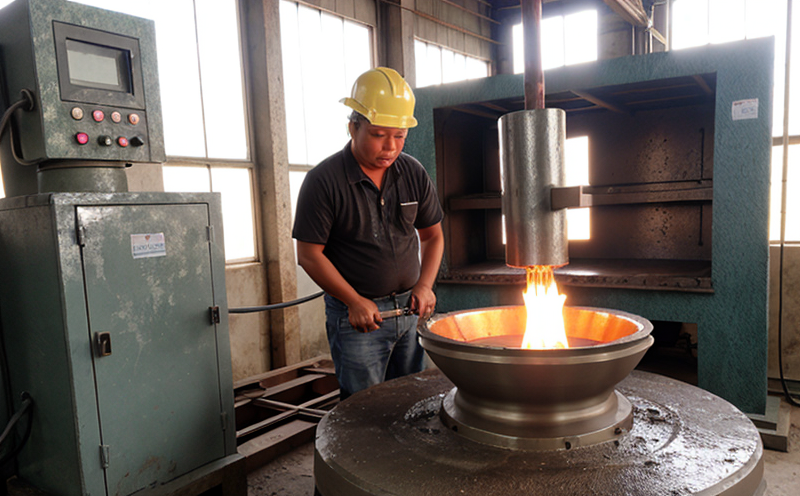ISO 8089 Corrosion Resistance Testing of Cast Metals
The ISO 8089 standard is a cornerstone in the evaluation and certification process for cast metals, particularly focusing on their resistance to corrosive environments. This testing method is critical for industries reliant on cast metal components where long-term durability and performance are paramount. The test measures the ability of cast metals to withstand corrosion under specified conditions, which can significantly impact product lifespan and reliability.
The testing process involves exposing a prepared sample of cast metal to an aggressive corrosive environment designed to mimic real-world conditions. This may include exposure to salt water, acid solutions, or other relevant corrosives for extended periods. The goal is to assess the rate at which the material corrodes under these conditions and compare it against industry standards.
One key aspect of this testing involves understanding the microstructure of the cast metal. The chemical composition and metallurgical properties play a crucial role in determining corrosion resistance. Therefore, prior to testing, specimens are meticulously prepared according to ISO 8089 guidelines to ensure accurate results. This includes cleaning the surface, removing any defects or impurities that could affect test outcomes.
The testing apparatus used for this method is highly specialized and designed to simulate various corrosive environments accurately. The equipment must be capable of maintaining precise temperature, humidity levels, and exposure durations as specified in ISO 8089. Additionally, the solution used for corrosion testing should closely replicate real-world conditions, whether it's salt spray or acid immersion.
The acceptance criteria for this test are stringent to ensure that only materials meeting rigorous standards pass. The results of the ISO 8089 testing can be used by manufacturers and quality control teams to make informed decisions about material selection, process improvements, and product design. This ensures compliance with industry standards and enhances customer confidence in products.
Understanding the implications of corrosion resistance is essential for industries such as automotive, aerospace, and marine, where cast metals are frequently used. By adhering to ISO 8089 guidelines, manufacturers can demonstrate their commitment to quality and reliability, ultimately contributing to safer and more durable products.
| Test Parameter | Description |
|---|---|
| Metal Specimen Preparation | Cleaning and conditioning the specimen according to ISO 8089 guidelines |
| Corrosive Environment Simulation | Exposure to salt water or acid solutions for specified durations |
| Sample Evaluation Criteria | Measurement of weight loss and visual inspection for pitting or erosion |
| Critical Testing Conditions | Description |
|---|---|
| Environmental Temperature | Maintained within a specified range to ensure consistent corrosion rates |
| Humidity Levels | Adjusted to replicate real-world conditions affecting corrosion |
| Corrosive Solution Composition | Specific formulations designed to mimic actual corrosive environments |
Why It Matters
The importance of ISO 8089 testing cannot be overstated, especially for industries where the integrity and durability of cast metals are critical. By ensuring that materials meet stringent corrosion resistance standards, manufacturers can prevent costly failures and enhance product reliability. This not only protects end-users but also strengthens brand reputation and customer trust.
The test results provide valuable insights into the performance characteristics of different cast metals under corrosive conditions. This information is invaluable for research and development teams looking to innovate and improve existing products or develop new materials with enhanced corrosion resistance. Furthermore, compliance with ISO 8089 standards can open doors to international markets where stringent quality controls are in place.
For procurement officers, the results of these tests offer a reliable basis for material selection, ensuring that only high-quality cast metals are sourced. This reduces the risk of supply chain disruptions and ensures consistent product performance across all batches. In summary, ISO 8089 testing is essential for maintaining quality standards, enhancing product reliability, and fostering trust in both domestic and international markets.
Applied Standards
The ISO 8089 standard provides a comprehensive framework for the corrosion resistance testing of cast metals. It specifies detailed procedures for specimen preparation, exposure conditions, and evaluation methods to ensure consistent and reliable test results. This standard is widely recognized and adopted by industries globally, making it an essential tool in quality assurance processes.
| Applied Standards | Description |
|---|---|
| ISO 8089:1987 | Casting alloys and their castings - Corrosion tests by exposure to salt spray in a climatic chamber |
| ASTM B117-20 | Standard Practice for Operating Salt Spray (Fog) Apparatus |
| IEC 68-2-14:2015 | Determination of resistance to salt spray corrosion - Salt fog chamber tests |
The application of these standards ensures that the testing process is standardized, making it easier for different laboratories and manufacturers to compare results. This standardization also facilitates compliance with international regulations, particularly in sectors like automotive and aerospace where quality control measures are stringent.
Competitive Advantage and Market Impact
The implementation of ISO 8089 testing provides significant competitive advantages for manufacturers. By adhering to these standards, companies can differentiate their products by offering higher levels of reliability and durability. This is particularly important in industries where the performance of cast metal components directly impacts product safety and longevity.
Compliance with ISO 8089 also enhances a company's reputation as a leader in quality assurance. This can attract more customers, leading to increased market share and profitability. Additionally, it opens up opportunities for business expansion into international markets where stringent quality standards are mandatory. In sectors like automotive and aerospace, where safety is paramount, compliance with these standards can be the deciding factor between winning or losing contracts.
In conclusion, ISO 8089 testing is not just a quality assurance measure; it's an essential tool for maintaining competitive advantage in the global market. By ensuring that cast metal components meet rigorous corrosion resistance standards, manufacturers can build trust with their customers and establish themselves as industry leaders.





